Introduction to Teriyaki Salmon Recipe
Cooking at home can sometimes feel challenging, but a Teriyaki Salmon Recipe can make the experience enjoyable and rewarding. This dish combines the rich flavors of salmon with a sweet and tangy teriyaki sauce, creating a perfect balance that pleases the palate. Why is this dish ideal for your dinner table?
Why Teriyaki Salmon is a Perfect Homemade Meal
First and foremost, it's quick to prepare. With just a few ingredients, you can transform a simple salmon fillet into a gourmet meal in under 30 minutes. The use of easily accessible ingredients like soy sauce, brown sugar, and ginger means you won’t have to hunt for obscure items.
Moreover, salmon is a powerhouse of nutrition—packed with omega-3 fatty acids, it’s as good for your health as it is delicious. Pair this meal with steamed vegetables or rice for a complete dinner that’s both satisfying and nourishing.
Lastly, the vibrant colors and aromatic experience while cooking are sure to impress anyone at your dinner table. Once you master this teriyaki salmon recipe, you’ll likely find yourself whipping it up for friends and family time and again. Ready to dive into this flavorful dish? Let’s get started!
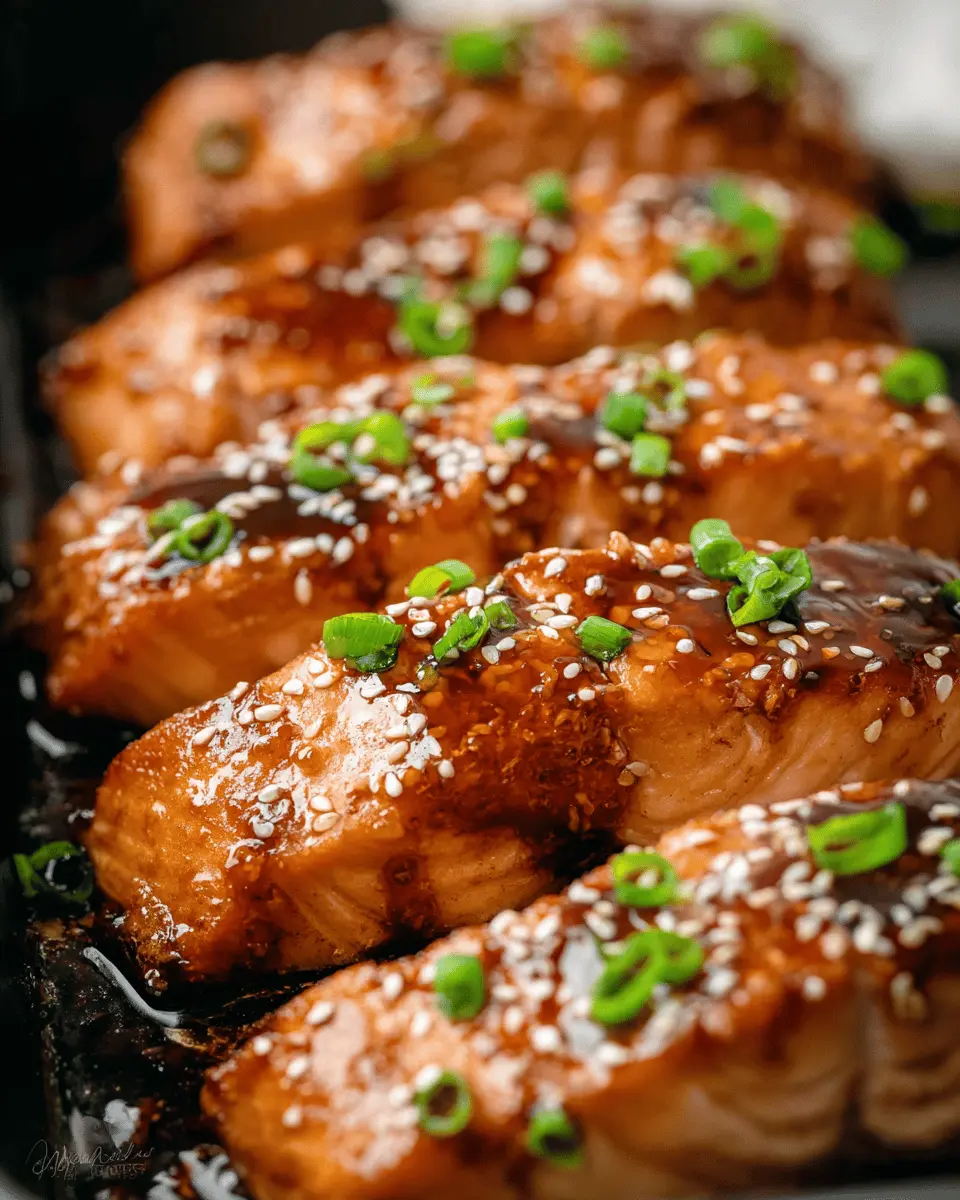
Ingredients for Teriyaki Salmon Recipe
Creating a delightful teriyaki salmon recipe at home starts with gathering the right ingredients. Here's a quick breakdown to ensure your dish turns out perfectly.
Essential Ingredients for the Salmon
For a superb salmon dish, you will need:
- 2 ½ lbs salmon filet: This should be sliced into 2-inch wide portions. Freshness is key! Always choose wild-caught if possible for enhanced flavor and nutrition.
Ingredients for the Teriyaki Sauce
This rich teriyaki sauce will elevate your salmon:
- 3 tablespoon teriyaki sauce
- 3 tablespoon hoisin sauce
- 3 tablespoon soy sauce: Opt for low-sodium versions if you're watching your salt intake.
- 1 tablespoon white vinegar
- 1 tablespoon sesame oil: A little goes a long way!
- ⅓ cup packed light brown sugar
- 2 large or 3 medium garlic cloves (minced)
- 2 teaspoon freshly grated ginger (or ½ teaspoon ground ginger)
Optional Garnishes
For that extra touch when serving, consider these delightful garnishes:
- Sesame seeds: Toast them for added flavor.
- Chopped green onion: This brings a fresh crunch to your dish.
By gathering these ingredients, you're on your way to a delicious teriyaki salmon recipe. Enjoy the cooking experience!
Preparing Teriyaki Salmon
Creating a delicious teriyaki salmon is simpler than you might think! Follow these steps to ensure your meal is packed with flavor and a hit at the dinner table.
Gather Your Ingredients
Before you dive into cooking, let’s gather all the essentials. For this teriyaki salmon recipe, you’ll need the following:
- 2 ½ lbs salmon filet, sliced into 2" wide pieces
- For the teriyaki sauce:
- 3 tablespoon teriyaki sauce
- 3 tablespoon hoisin sauce
- 3 tablespoon soy sauce
- 1 tablespoon white vinegar
- 1 tablespoon sesame oil
- ⅓ cup packed light brown sugar
- 2 large or 3 medium garlic cloves, minced
- 2 teaspoon freshly grated ginger (or ½ teaspoon ground ginger)
- Optional for serving: sesame seeds and chopped green onion
Having everything on hand makes the cooking process smooth and enjoyable. This also minimizes those last-minute dashes to the store!
Prepare the Teriyaki Sauce
Now it’s time to whip up your homemade teriyaki sauce! In a mixing bowl, combine the teriyaki sauce, hoisin sauce, soy sauce, white vinegar, sesame oil, light brown sugar, minced garlic, and ginger. Stir everything together until the brown sugar dissolves. The aroma at this stage will be so enticing that you may find yourself dreaming about how great the final dish will be!
For a deeper dive into the benefits of homemade sauces over store-bought options, check out this article on healthy cooking tips.
Marinate the Salmon
Place your salmon pieces in a mixing bowl and pour the teriyaki sauce over them. Cover the bowl with plastic wrap and let it marinate for about 20 minutes at room temperature. This step allows all those flavorful ingredients to soak into the fish, ensuring that each bite bursts with savory goodness.
Bake the Salmon
After marinating, transfer the salmon pieces to a greased baking sheet (cover it with foil for easy cleanup). Preheat your oven to 400˚F and bake the salmon for 12-16 minutes, depending on the thickness of your fillets. Keep an eye on them; you want the salmon to be flaky and tender, not overcooked.
Create the Teriyaki Syrup
While your salmon is baking, take the remaining marinade and pour it into a small saucepan. Bring it to a boil, then reduce to a simmer. Let it cook for about 3-4 minutes, stirring occasionally until it thickens slightly into a syrup. This teriyaki syrup will elevate your dish, adding an extra layer of flavor once you brush it over the cooked salmon.
Once everything is done, garnish with sesame seeds and chopped green onions, if you like. Enjoy your homemade teriyaki salmon and impress your guests with your culinary skills!
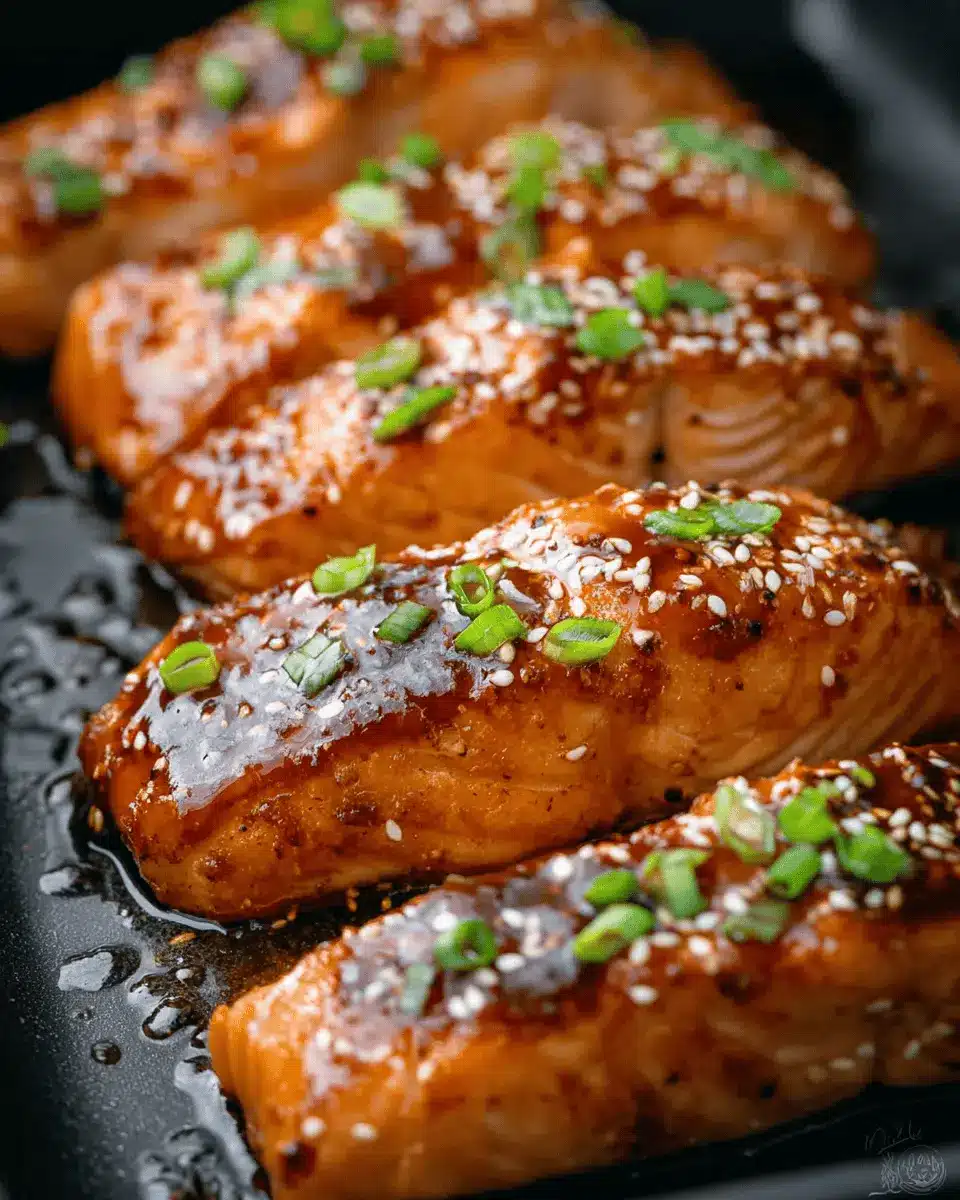
Variations on Teriyaki Salmon
Teriyaki Salmon with Vegetables
For a colorful and nutritious twist, try your teriyaki salmon recipe with seasonal vegetables. Simply toss your favorite veggies like bell peppers, broccoli, and snap peas in the marinade before roasting them alongside the salmon. This adds vibrant flavor and a lovely crunch, creating a well-rounded meal. Plus, the power of greens can boost your health—did you know that incorporating vegetables into your meals can lower the risk of chronic diseases? It's a delicious way to elevate your dinner!
Grilled Teriyaki Salmon
Take your teriyaki experience outdoors by making grilled teriyaki salmon. Just marinate the salmon as usual and then fire up the grill. Grill each slice for about 4-5 minutes per side, or until grill marks appear and it flakes easily with a fork. This method imparts a subtle smokiness that complements the sweet teriyaki flavors beautifully. If you enjoy the outdoors, grilling not only makes cooking easier, but also takes dinner al fresco!
Feel free to share your variations in the comments! Happy cooking!
Cooking Tips and Notes for Teriyaki Salmon
Choosing the Right Salmon
When making this teriyaki salmon recipe, opt for fresh, wild-caught salmon if possible. Varieties like sockeye or king salmon offer rich flavors and optimal texture. Look for vibrant, bright colors and a firm texture; avoid fish with dull appearances or strong odors.
Ensuring Flaky Perfection
For the best results, let your salmon rest at room temperature for about 10-15 minutes before baking. This step helps it cook evenly, resulting in that desirable flaky texture. If your salmon is particularly thick, don't hesitate to adjust baking time slightly—trust your instincts and check for doneness by flaking with a fork. Enjoy your delicious, homemade teriyaki salmon!
For more seafood tips, check out Seafood Watch for sustainable choices!
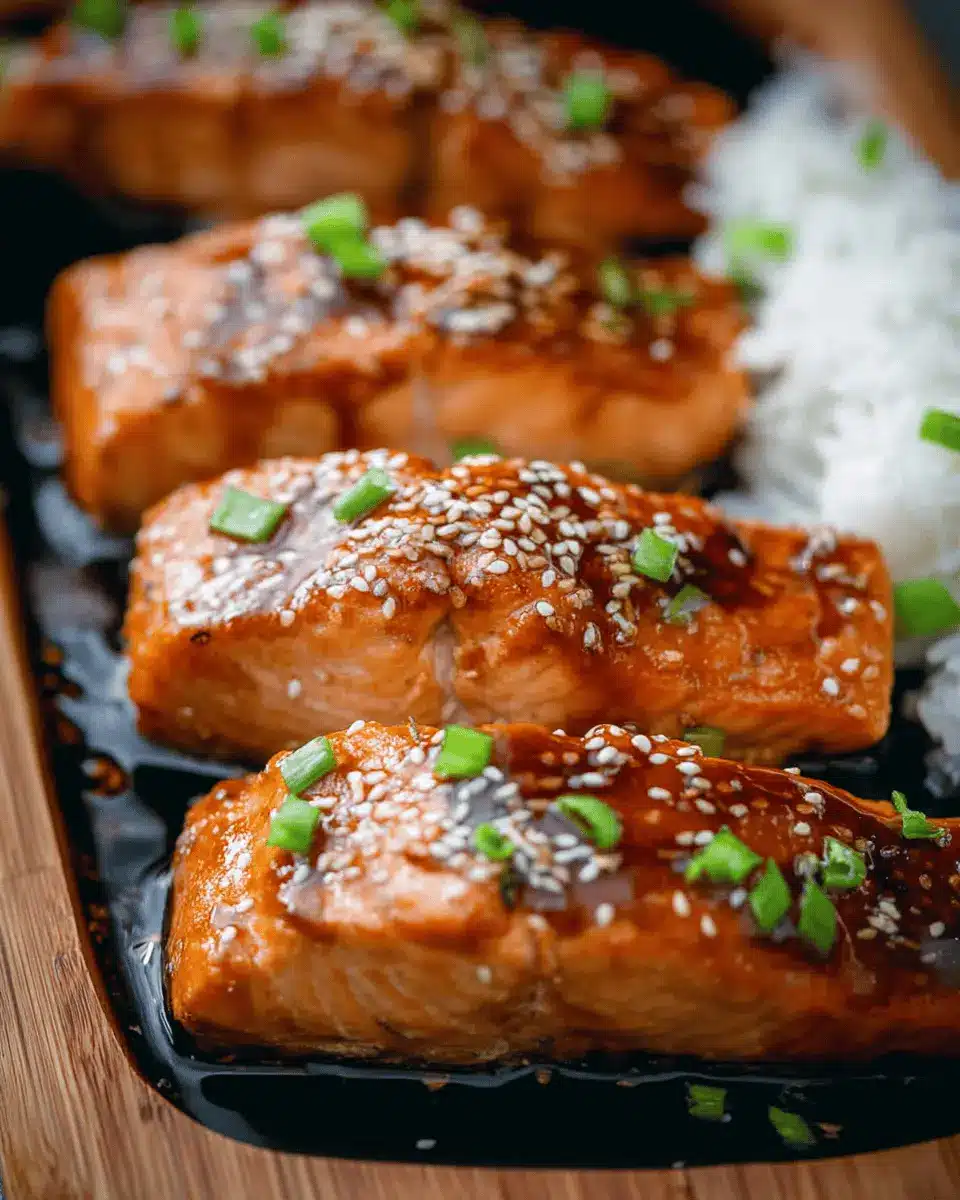
Serving Suggestions for Teriyaki Salmon
Complementary Side Dishes
Pair your teriyaki salmon with a variety of side dishes to create a balanced meal. Consider adding:
- Steamed jasmine rice or quinoa for a fluffy base.
- Sautéed vegetables like bok choy or snap peas for a pop of color and crunch.
- Fresh cucumber salad to bring a refreshing element to your plate.
These sides not only complement the dish but also enhance the overall dining experience, allowing the sweet and savory flavors of the salmon to shine.
Plating and Presentation Tips
When it comes to presentation, you want your dish to be as inviting as it is delicious. Here are a few ideas:
- Use a white plate to create contrast and make the teriyaki salmon stand out.
- Drizzle your thickened teriyaki sauce artistically over the salmon, and add a sprinkle of sesame seeds and chopped green onions.
- Consider a side of vibrant vegetables arranged neatly for a restaurant-style look.
With these easy serving suggestions, your teriyaki salmon recipe will not only taste incredible but also look fabulous on the table!
Time Breakdown for Teriyaki Salmon
Preparation Time
Get your kitchen ready! You'll need about 20 minutes to prep the salmon and whip up that delightful teriyaki sauce.
Cooking Time
Once everything’s set, it’s time to bake. Your salmon will need 12-16 minutes in the oven to achieve the perfect flaky texture.
Total Time
In just under 40 minutes, you’ll have a mouthwatering teriyaki salmon meal ready to impress your friends or family. Quick, easy, and absolutely delicious!
This teriyaki salmon recipe not only fits into your busy schedule but also promises a taste sensation that’s hard to resist. Happy cooking!
Nutritional Facts for Teriyaki Salmon
When diving into this delicious teriyaki salmon recipe, knowing its nutritional profile can help you make informed choices. Here’s a quick look at what each serving offers:
Calories
Each serving of teriyaki salmon contains approximately 276 calories, making it a great option for a healthy meal.
Protein
You'll enjoy a hearty 29 grams of protein per serving, which is essential for muscle repair and overall health.
Fats
This dish has about 10 grams of fat, mainly from the salmon and sesame oil, providing healthy omega-3 fatty acids that support heart health.
For more on the health benefits of salmon, check out Salmon Nutrition provided by the FDA. This blend of flavors and nutrients makes this teriyaki salmon a fantastic choice for a quick weeknight dinner!
FAQ about Teriyaki Salmon
Can I use other fish for this recipe?
Absolutely! While our teriyaki salmon recipe is tailored for salmon, you can experiment with other fish like tilapia, trout, or mahi-mahi. Just keep in mind that different fish may require slight adjustments in cooking times due to varying thickness and texture.
How do I store leftovers?
If you find yourself with any leftovers, simply transfer the cooled salmon to an airtight container and store it in the refrigerator for up to three days. You can also freeze it for longer storage—just ensure it's tightly wrapped or in a freezer-safe container!
What can I substitute for soy sauce?
Great question! If you need a soy-free option, consider using coconut aminos or even a low-sodium tamari for a similar flavor profile. Additionally, you can create a homemade alternative by mixing equal parts of vinegar and a little bit of water, adding a dash of seasoning for extra flavor.
Feel free to ask more questions in the comments, and happy cooking!
Conclusion on Teriyaki Salmon Recipe
In summary, this teriyaki salmon recipe delivers an incredibly flavorful dish that's both simple to prepare and satisfying to eat. Perfect for weeknights or special occasions, it's a great way to introduce savory Asian flavors into your meals. Give it a try, and enjoy the delightful taste of homemade teriyaki sauce!
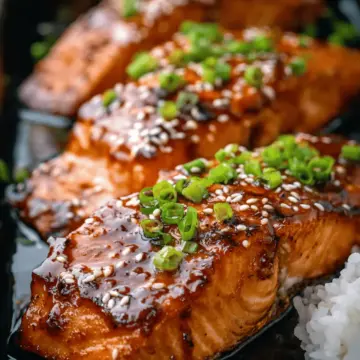
Teriyaki Salmon Recipe
Equipment
- Oven
- baking sheet
- mixing bowl
- Sauce pan
- plastic wrap
Ingredients
Teriyaki Salmon
- 2.5 lbs salmon filet sliced into 2" wide slices
Teriyaki Sauce
- 3 tablespoon teriyaki sauce
- 3 tablespoon hoisin sauce
- 3 tablespoon soy sauce
- 1 tablespoon white vinegar
- 1 tablespoon sesame oil
- ⅓ cup light brown sugar packed
- 2 large garlic cloves minced
- 2 teaspoon freshly grated ginger or ½ teaspoon ground ginger
To serve
- sesame seeds to garnish, optional
- green onion chopped, optional
Instructions
Preparation
- Grease a large rimmed baking sheet (cover with foil and then grease for easier clean-up). Preheat oven to 400˚F.
Cooking Instructions
- Combine sauce ingredients and stir until brown sugar is dissolved.
- Place individual salmon slices in a mixing bowl. Pour the sauce over the salmon, cover with plastic wrap and let marinate 20 minutes (at room temp or refrigerated).
- Transfer salmon to prepared baking sheet (keep the marinade). Bake at 400 for 12-16 min or until salmon is flaky and cooked through, bake times may vary by thickness of salmon.
- While salmon is baking, transfer remaining marinade to a small sauce pan and bring to a boil then reduce heat to a simmer and cook, stirring occasionally until slightly thickened (3-4 min) then remove from heat.
- Once salmon is out of the oven, brush with teriyaki syrup, then sprinkle with chopped green onion and sesame seeds as desired.




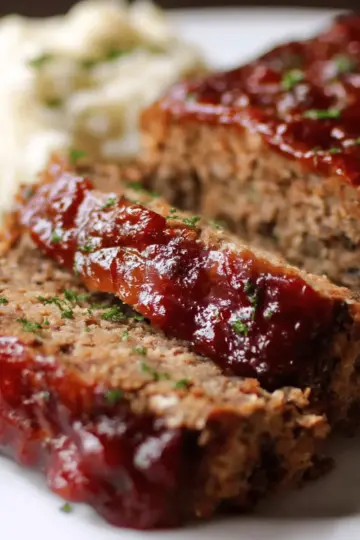
Leave a Reply